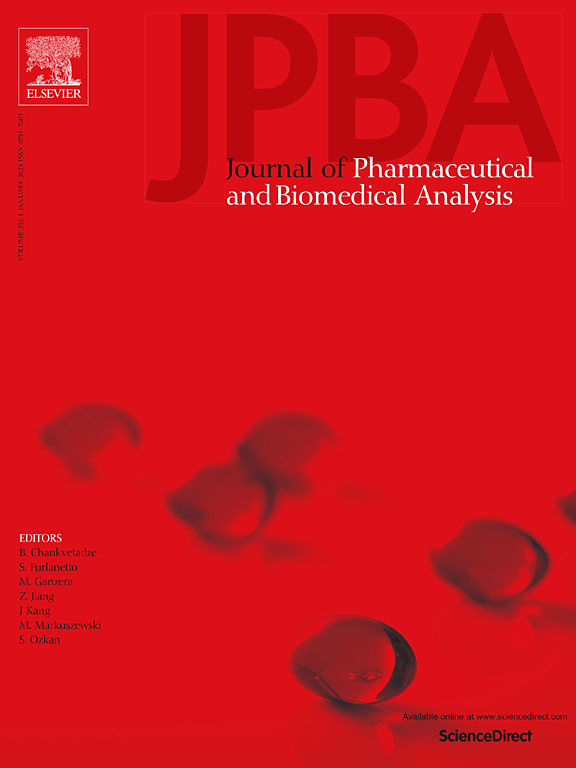Investigation and elimination of noncovalent artificial aggregates during non-reduced capillary electrophoresis-sodium dodecyl sulfate analysis of a multi-specific antibody
IF 3.1
3区 医学
Q2 CHEMISTRY, ANALYTICAL
Journal of pharmaceutical and biomedical analysis
Pub Date : 2025-01-08
DOI:10.1016/j.jpba.2025.116673
引用次数: 0
Abstract
Capillary electrophoresis-sodium dodecyl sulfate (CE-SDS) is widely used in the biopharmaceutical industry for monitoring purity and analyzing impurities. The accuracy of the method may be compromised by artificial species resulting from sample preparation or electrophoresis separation due to suboptimal conditions. During non-reduced CE-SDS analysis of a multispecific antibody (msAb), named as multispecific antibody C (msAb-C), a cluster of unexpected peaks was observed after the main peak. The corrected peak area ratio of these peaks showed a strong dependence on loaded protein concentration, which affected the accurate assessment of the purity of msAb-C. After investigation, the unexpected peaks were identified as artifacts produced during electrophoresis separation. These artifacts can be mitigated by three different strategies: 1) adding a more hydrophobic surfactant, sodium hexadecyl sulfate (SHS), to the sample and/or sieving gel buffer; 2) reducing the sample loading amount; and 3) increasing the capillary separation temperature to above 40 ℃. We adopted strategy 1) and strategy 3), and successfully developed an optimal non-reduced CE-SDS method for the accurate and reliable purity assessment of msAb-C samples. These strategies of optimizing non-reduced CE-SDS can be used in developing quality control methods for other therapeutic bispecific/multispecific antibodies.
非还原毛细管电泳过程中非共价人工聚集体的研究与消除——一种多特异性抗体的十二烷基硫酸钠分析。
毛细管电泳-十二烷基硫酸钠(CE-SDS)广泛应用于生物制药行业的纯度监测和杂质分析。由于次优条件,该方法的准确性可能因样品制备或电泳分离产生的人工物种而受到损害。在对多特异性抗体C (msAb-C)进行非还原CE-SDS分析时,在主峰后观察到一簇意想不到的峰。校正后的峰面积比与载蛋白浓度有很大关系,影响了对msAb-C纯度的准确评价。经过调查,意外的峰被确定为在电泳分离过程中产生的伪影。这些伪影可以通过三种不同的策略来减轻:1)在样品和/或筛分凝胶缓冲液中添加更疏水的表面活性剂,十六烷基硫酸钠(SHS);2)减少样品装填量;3)提高毛细管分离温度至40℃以上。我们采用策略1)和策略3),成功开发了一种最佳的非还原CE-SDS方法,可以准确可靠地评估mabs - c样品的纯度。这些优化非还原CE-SDS的策略可用于开发其他治疗性双特异性/多特异性抗体的质量控制方法。
本文章由计算机程序翻译,如有差异,请以英文原文为准。
求助全文
约1分钟内获得全文
求助全文
来源期刊
CiteScore
6.70
自引率
5.90%
发文量
588
审稿时长
37 days
期刊介绍:
This journal is an international medium directed towards the needs of academic, clinical, government and industrial analysis by publishing original research reports and critical reviews on pharmaceutical and biomedical analysis. It covers the interdisciplinary aspects of analysis in the pharmaceutical, biomedical and clinical sciences, including developments in analytical methodology, instrumentation, computation and interpretation. Submissions on novel applications focusing on drug purity and stability studies, pharmacokinetics, therapeutic monitoring, metabolic profiling; drug-related aspects of analytical biochemistry and forensic toxicology; quality assurance in the pharmaceutical industry are also welcome.
Studies from areas of well established and poorly selective methods, such as UV-VIS spectrophotometry (including derivative and multi-wavelength measurements), basic electroanalytical (potentiometric, polarographic and voltammetric) methods, fluorimetry, flow-injection analysis, etc. are accepted for publication in exceptional cases only, if a unique and substantial advantage over presently known systems is demonstrated. The same applies to the assay of simple drug formulations by any kind of methods and the determination of drugs in biological samples based merely on spiked samples. Drug purity/stability studies should contain information on the structure elucidation of the impurities/degradants.

 求助内容:
求助内容: 应助结果提醒方式:
应助结果提醒方式:


